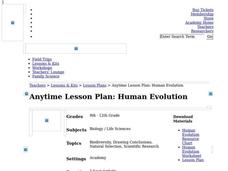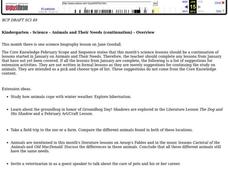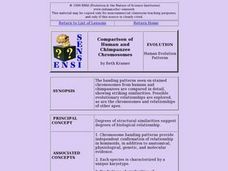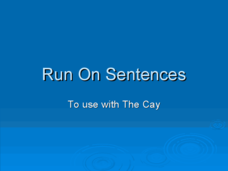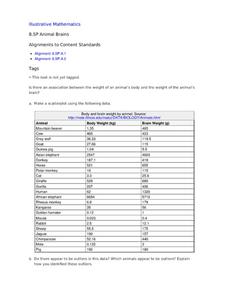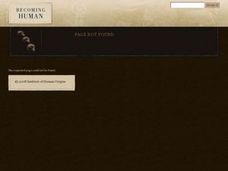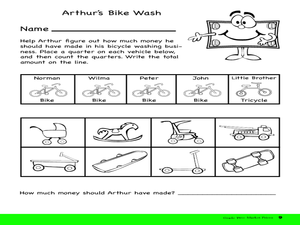Curated OER
Chimpanzees: We're Not Entertained
Students explore multiple perspectives to create a talk show that examines the issues facing chimpanzees. They analyze the gray areas of controversial issues to realize that there can be a wide range of possible positions on a given issue.
Curated OER
Jane Goodall, Renowned Naturalist and Champion of Chimpanzees
Students study the life of Jane Goodall and how she made an impact studying chimpanzees. In this endangered species lesson students write in their journals.
California Academy of Science
Human Evolution
As the great and hilarious Tim Minchin once said, "Science is simply the word we use to describe a method of organizing our curiosity." Science is more than just a guess; it is based on questions, observations, and evidence. High...
Curated OER
Comparing Fossils
Students explore early hominid evolution as they analyze bones that share characteristics of both apes and humans. Students compare and contrast key skeletal differences between chimpanzees and humans. In groups, they sort and group a...
Curated OER
Jane Goodall
Students identify Jane Goodall as a scientist who studies the behavior of chimpanzees. They listen to a biography of Jane Goodall and review the location of Africa. Then students participate in an animal observation activity.
Curated OER
Comparison of Human and Chimpanzee Chromosomes
Students actively engage in the careful analysis of chromosome banding patterns and identify examples of inversion in homologous chromosomes.
Curated OER
Comparing Chimp mtDNA to Learn about Races
In this computer-based activity, students will measure genetic diversity within and between three subspecies of chimpanzees in order to gain a better understanding of genetic distinctiveness and explore race as a genetic concept.
Curated OER
Studying Fossils
Young scholars compare and contrast key skeletal differences between chimpanzees and humans: brain size, teeth, hand and thumb, trunk, pelvis, lower limb, foot and big toe. They then sort and group a set of mixed "fossil bones" of...
Curated OER
Pseudogene Suite
Students use Biology Workbench to explore DNA sequence data for the GULOP gene in humans, chimpanzees, orangutans, and crab-eating macaques and the beta globin gene and its pseduogene in humans, gorillas, and chimpanzees.
Curated OER
Hominoid Cranium Comparison
High schoolers describe, measure and compare cranial casts from contemporary apes (chimpanzees and gorillas, typically), modern humans and fossil "hominids" (erect and bipedal forms evolutionarily separated from apes).
Curated OER
Ape Genius
Pupils watch a video and discuss the research on the intelligence of apes. In this primate lesson, students view a NOVA video about ape intelligence. They work in groups to take notes on the observations and conclusions of researchers...
Curated OER
What Can Pseudogenes Tell Us About Common Ancestry?
Learners compare/constrast DNA sequence data for a portion of the rat GULO gene to the corresponding sequence in the inactive GULO gene in humans, chimpanzees, orangutans, and crab-eating macaques by identifying the shared sequences in...
Curated OER
From Genomes of Species
Students investigate genomic research being done and its potential for understanding, treating, and possibly curing human genetic conditions. The potential of proteomic research as a companion to the work being done with genomics is...
Curated OER
Run On Sentences - To Use with The Cay
An outstanding presentation on what run-on sentences are, and how to fix them, awaits your class in this language arts PowerPoint. They are shown four different methods they can use to fix a run-on sentence. This presentation is meant to...
Curated OER
Rainforest Rescue
Students explore threats to diversity in the Central African rainforest. They use a guided website to research animals that are threatened with extinction, examine human uses of the rainforest and think about what they can do to help...
University of Arizona
Yoruba Legends: Southern Nigeria
Explore legends and storytelling with your learners. After listening to some legends, pupils work collaboratively and then individually to come up with original legends about animals.
EngageNY
Interpreting Residuals from a Line
What does an animal's gestation period have to do with its longevity? Use residuals to determine the prediction errors based upon a least-square regression line. This second lesson plan on residuals shows how to use residuals to...
Curated OER
Animal Brains
Do big bodies make big brains? Let your learners decide whether there is an association between body weight and brain weight by putting the data from different animals into a scatterplot. They can remove any outliers and then make a line...
Curated OER
Building Bodies
Students identify key anatomical similarities and differences between great apes and humans. They infer likely anatomical features in ancient human ancestors and list principal anatomical changes in primates necessary for adaptation to...
Curated OER
Disney's Animal World Part 2: That's My Baby
Students see that baby animals go through different stages of growth during their life, just as people do. They use the downloadable Cyberlesson Worksheet to reinforce what they have learned about animals and their offspring.
Curated OER
Can Chimps Talk?
Students view a video about chimps and language. They work together to role play the roles of researchers and chimps in an experiment. They agree on a way to live together and each group be treated fairly.
Curated OER
Animal Communication
Students use three nonfiction selections in order to investigate the concept of animal communication. They use a graphic organizer for the information as it is gathered in the reading.
Curated OER
Comparing and Contrasting a Desert Reptile and a Rainforest Mammal
First graders compare and contrast two different type of animals while also making predictions, observations, and asking provocative questioning. For this compare and contrast lesson, 1st graders acquire knowledge about why some animals...
Curated OER
Market Prices
Second graders understand that prices change. In this business, price and labor lesson, 2nd graders define the words market and price. Students read Arthur's Funny Money and answer questions related to earning and spending money....
Other popular searches
- Chimpanzees & Bonobos
- Chimpanzees & Bonbons
- Chimpanzees Food Chain
- Drawing Chimpanzees
- Endangered Chimpanzees
- Chimpanzees Bonobos
- Chimpanzees Worksheets
- Environment, Chimpanzees
- Chimpanzees Bonbons
- Endangerd Chimpanzees
- Environment Chimpanzees


